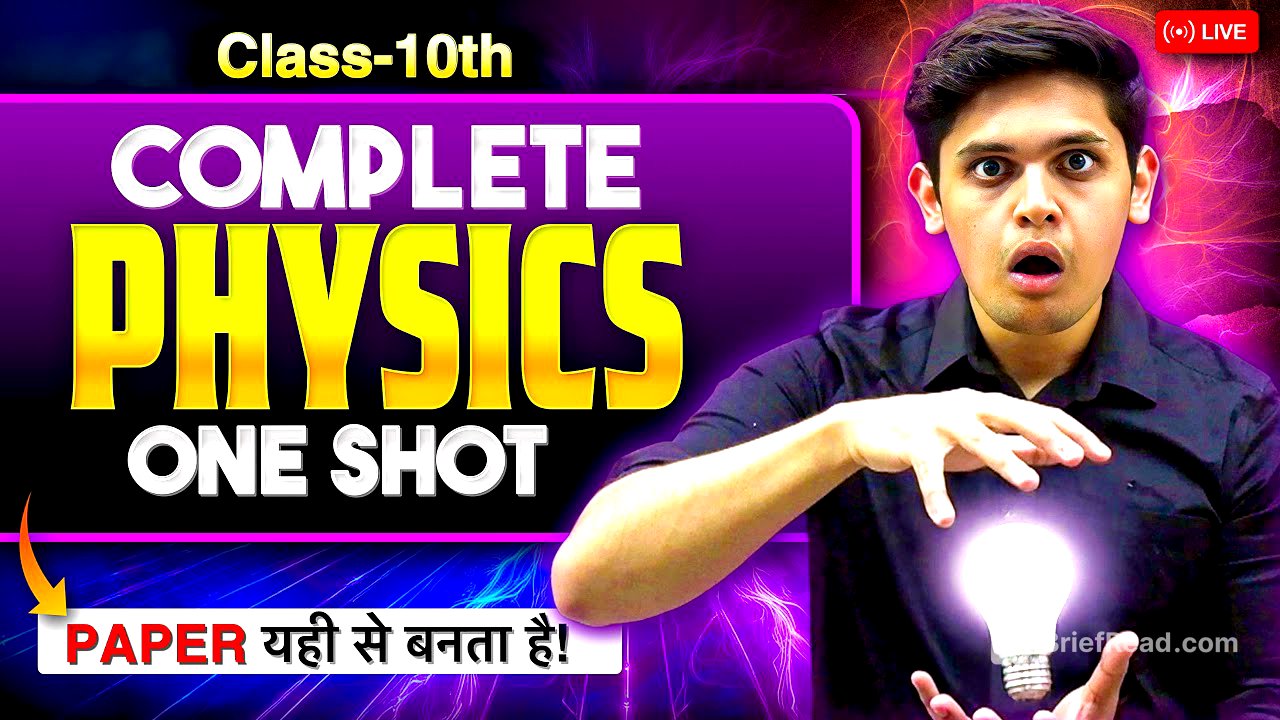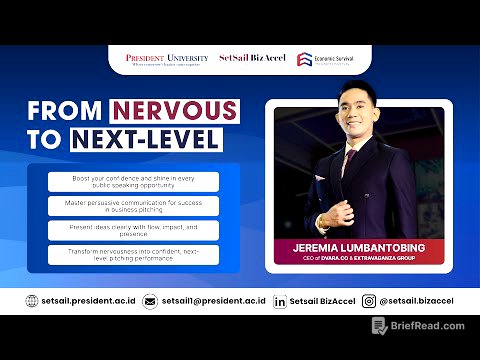TLDR;
This YouTube video is a comprehensive physics marathon for 9th and 10th-grade students, focusing on key concepts, problem-solving techniques, and important formulas. The instructor provides cheat notes, memory tricks, and real-world examples to help students understand and retain the material. The session covers electricity, magnetism, and light, with a focus on understanding concepts and applying them to exam-style questions.
- Covers electricity, magnetism and light
- Provides cheat notes and memory tricks
- Focuses on understanding concepts and applying them to exam-style questions
Introduction [0:03]
The instructor begins by setting an energetic tone for the physics marathon, emphasizing its importance for class 10th board exams. He assures students that the session will cover essential topics and provide cheat notes to aid revision. The instructor expresses his commitment to helping students overcome their fear of physics by focusing on understanding concepts rather than rote memorization.
Chemistry Marathon Recap and Upcoming Sessions [1:10]
The instructor briefly recaps the previous chemistry marathon, expressing hope that students found it helpful. He announces upcoming sessions, including a science discussion on the 19th and a session on the 20th at 4:00 AM, promising new revision methods.
Important Topics in Physics [4:51]
The instructor outlines the important topics in physics, including mirror and lens formulas, the power of a lens, Snell's law, ray diagrams, series and parallel derivations, Ohm's law, Fleming's left-hand rule, and solenoids. He emphasizes that the exam paper will be primarily based on these topics.
Electricity: Conductors, Insulators, and Electric Charge [6:05]
The lecture begins with a discussion on electricity, differentiating between conductors, insulators, and semiconductors. Electric charge is defined as a property that causes the experience of force, with its unit being the coulomb (C). The properties of electric charge, including additivity, conservation, invariance, and quantization, are explained with examples.
Quantization of Charge and Related Problems [8:56]
The concept of quantization of charge is explained using the analogy of buying sweets, illustrating that charge can only be in discrete multiples of the electron charge (e = 1.6 x 10^-19 C). The formula q = n * e is introduced, and a question is posed to calculate the number of electrons in one coulomb of charge.
Electric Current: Definition and Formula [12:12]
Electric current is defined, and its formula (I = Q/t) is introduced. The unit of current, ampere (A), is explained, and the direction of current flow in a battery (positive to negative) and electron flow (negative to positive) are clarified.
Potential Difference: Definition and Formula [14:57]
Potential difference is defined as the work done to move a unit charge from one place to another, with the formula V = W/Q. The unit of potential difference, volt (V), is explained, and a question is posed to calculate the work done in moving a charge across two points with a given potential difference.
Problem Solving: Applying Formulas for Current and Charge [18:37]
The instructor demonstrates how to solve problems related to electric current and charge, emphasizing the importance of writing down the given information and using the correct formulas. He solves an example problem involving the calculation of charge and the number of electrons.
Electric Circuits and Components [21:21]
The components of an electric circuit, including electric cells, batteries, open and closed switches, resistance, ammeters, and voltmeters, are explained. The schematic diagram of an electric circuit is discussed, and the differences between ammeters and voltmeters are highlighted.
Ohm's Law and Resistance [25:18]
Ohm's law (V = IR) is introduced, and resistance is defined as the obstruction to the flow of current. The factors affecting resistance, including length, area, temperature, and the nature of the material (resistivity), are explained with real-world examples.
Resistivity and Related Problems [29:00]
Resistivity is defined as a material property that affects resistance. The formula R = ρ(L/A) is introduced, and several problems related to resistance and resistivity are solved, including scenarios where the length and area of a wire are changed.
Series and Parallel Combinations of Resistors [44:56]
Series and parallel combinations of resistors are explained, with formulas for calculating equivalent resistance. Memory tricks for remembering the formulas and derivations are provided. Problems related to series and parallel combinations are solved.
Electric Power and Energy [1:08:51]
Electric power is defined as the rate of energy consumption, with its unit being the watt (W). The formulas for power (P = VI, P = V^2/R, P = I^2R) are introduced. Electric energy is defined as power multiplied by time, with its unit being the kilowatt-hour (kWh).
Applications of Heating Effect of Electric Current [1:02:51]
The heating effect of electric current (Joule's law) is explained, with the formula H = I^2Rt. Applications of this effect, including electric fuses, electric bulbs, and electric heaters, are discussed. The materials used in these applications (e.g., tungsten in bulbs, nichrome in heaters) are highlighted.
Problem Solving: Power and Energy Calculations [1:13:11]
The instructor solves several problems related to electric power and energy, including calculating the energy consumed by household appliances and the cost of electricity bills. He also discusses tricky questions related to power and resistance in circuits.
Magnetic Effects of Electric Current: Introduction [1:29:44]
The chapter on the magnetic effects of electric current begins with an introduction to magnetism and the Earth's magnetic field. Oersted's experiment, which demonstrated the relationship between electricity and magnetism, is explained.
Bar Magnets and Magnetic Fields [1:32:38]
The properties of bar magnets, including attractive and repulsive forces and the concept of magnetic poles, are discussed. Magnetic fields and magnetic field lines are explained, with a focus on their properties, such as originating from the north pole and forming closed loops.
Maxwell's Right-Hand Thumb Rule [1:38:11]
Maxwell's right-hand thumb rule is introduced as a way to determine the direction of the magnetic field around a current-carrying conductor. The concept of concentric circles and the convention of using crosses and dots to represent magnetic fields going in and out of the page are explained.
Magnetic Field Due to Current-Carrying Loop and Solenoids [1:42:20]
The magnetic field due to a current-carrying loop is discussed, with a focus on the circular field at the ends and the straight field at the center. Solenoids are introduced, and their magnetic field patterns are compared to those of bar magnets.
Electromagnets and Their Advantages [1:49:48]
Electromagnets are defined as solenoids with an iron core, and their advantages over permanent magnets are highlighted. These advantages include the ability to change the strength and polarity of the magnetic field and the dependence on current flow.
Fleming's Left-Hand Rule [1:56:03]
Fleming's left-hand rule is introduced as a way to determine the direction of the force on a current-carrying conductor in a magnetic field. The thumb, index finger, and middle finger are used to represent force, magnetic field, and current, respectively.
Domestic Electric Circuits and Safety Measures [2:04:51]
The components of a domestic electric circuit, including live, neutral, and earth wires, are explained. The function of the earth wire in preventing electric shock is highlighted. Short circuits and overloading are defined, and the role of electric fuses in preventing damage is discussed.
AC vs. DC Current [2:11:15]
The differences between alternating current (AC) and direct current (DC) are explained, including the changing direction of AC, its suitability for long-distance transmission, and its frequency.
Light: Reflection and Laws of Reflection [2:19:58]
The chapter on light begins with a discussion on reflection, defined as the bouncing back of light. The laws of reflection, including the equality of the angle of incidence and the angle of reflection, are explained.
Plane Mirrors: Properties and Focal Length [2:21:36]
The properties of plane mirrors, including lateral inversion, erect images, and the same size and distance of the image, are discussed. The focal length of a plane mirror is stated as infinity.
Concave and Convex Mirrors: Definitions and Key Terms [2:24:23]
Concave and convex mirrors are defined, and key terms such as pole, center of curvature, principal axis, principal focus, focal length, and aperture are explained. The relationship between the radius of curvature and focal length (R = 2f) is highlighted.
Ray Diagrams for Concave Mirrors: Rules and Techniques [2:26:58]
The rules for drawing ray diagrams for concave mirrors are explained, including the behavior of light rays that are parallel to the principal axis, pass through the focus, or pass through the center of curvature.
Image Formation in Concave Mirrors: Different Cases [2:29:19]
The different cases of image formation in concave mirrors, depending on the position of the object, are discussed. These cases include the object at infinity, beyond the center of curvature, at the center of curvature, between the center of curvature and focus, at the focus, and between the focus and the pole.
Hacker Approach for Concave Mirror Ray Diagrams [2:35:13]
A hacker approach for remembering the image formation in concave mirrors is introduced, involving a numbering system to quickly determine the position and properties of the image.
Image Formation in Convex Mirrors [2:37:17]
The image formation in convex mirrors is discussed, with a focus on the two cases: the object at infinity and the object at any other position. The properties of the images formed (virtual, erect, diminished) are highlighted.
Uses of Concave and Convex Mirrors [2:38:40]
The uses of concave and convex mirrors are explained, including concave mirrors in headlights and solar furnaces and convex mirrors in rearview mirrors of vehicles.
Refraction and Laws of Refraction [2:58:44]
Refraction is defined as the bending of light, and its cause (difference in speed in different mediums) is explained. The laws of refraction, including Snell's law, are introduced.
Refractive Index: Definition and Formula [3:02:48]
Refractive index is defined as a measure of how much light is bent by a medium, and its formula (n = c/v) is introduced. The relationship between refractive index, density, and the speed of light is explained.
Refraction Through a Glass Slab [3:04:47]
Refraction through a glass slab is discussed, with a focus on the bending of light rays at the air-glass and glass-air interfaces. The concept of lateral displacement is explained.
Lenses: Types and Key Terms [3:12:43]
Convex and concave lenses are defined, and key terms such as optical center, principal axis, and principal focus are explained.
Ray Diagrams for Lenses: Rules and Techniques [3:13:52]
The rules for drawing ray diagrams for lenses are explained, including the behavior of light rays that are parallel to the principal axis, pass through the focus, or pass through the optical center.
Image Formation in Convex Lenses: Different Cases [3:16:17]
The different cases of image formation in convex lenses, depending on the position of the object, are discussed. These cases include the object at infinity, beyond 2f1, at 2f1, between 2f1 and f1, at f1, and between f1 and the optical center.
Hacker Approach for Convex Lens Ray Diagrams [3:18:58]
A hacker approach for remembering the image formation in convex lenses is introduced, involving a numbering system to quickly determine the position and properties of the image.
Image Formation in Concave Lenses [3:20:33]
The image formation in concave lenses is discussed, with a focus on the two cases: the object at infinity and the object at any other position. The properties of the images formed (virtual, erect, diminished) are highlighted.
Uses of Convex and Concave Lenses [3:21:56]
The uses of convex and concave lenses are explained, including convex lenses in magnifying glasses, projectors, cameras, and telescopes, and concave lenses in spyholes.
Power of a Lens: Definition and Formula [3:24:02]
The power of a lens is defined as its ability to converge or diverge light, with its unit being the diopter (D). The formula for power (P = 1/f) is introduced, and the sign conventions for the focal length of convex and concave lenses are explained.
The Human Eye: Structure and Functions [3:35:16]
The structure of the human eye, including the cornea, aqueous humor, pupil, iris, lens, ciliary muscle, vitreous humor, retina, rods, cones, sclera, and optic nerve, is explained. The functions of each component are highlighted.
Power of Accommodation [3:40:28]
The power of accommodation is defined as the ability of the human eye to change the focal length of its lens to focus on objects at different distances. The roles of the ciliary muscle and the lens in this process are explained.
Defects of Vision: Myopia and Hypermetropia [3:44:36]
Myopia (nearsightedness) and hypermetropia (farsightedness) are introduced as common defects of vision. The causes of these defects, including excessive curvature of the eye lens and elongation of the eyeball, are explained.









